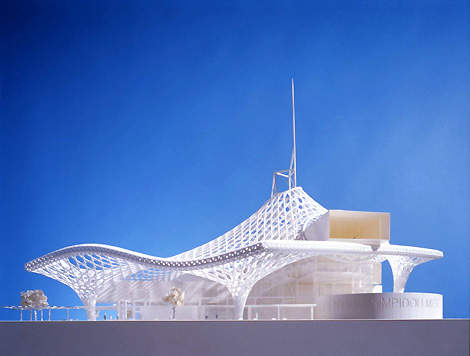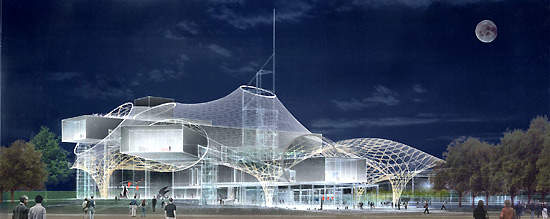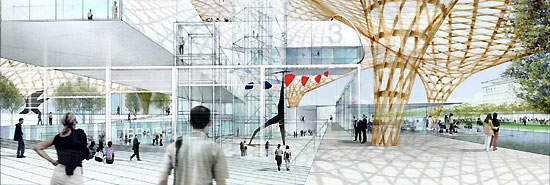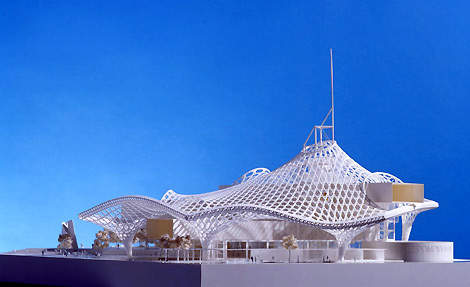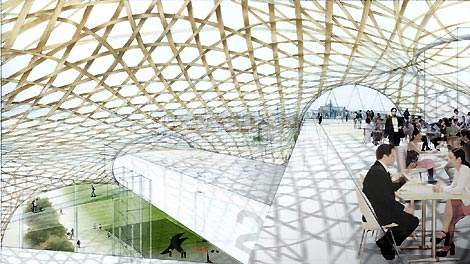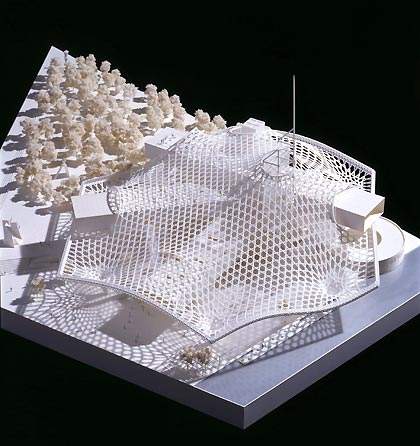France’s first Pompidou Centre outside of Paris opened in the city of Metz, eastern France, in May 2010. The centre was designed by Shigeru Ban Architects (SBA – Tokyo) in association with Jean de Gastines (Paris) and Gumuchdjian Architects (London).
The €86m centre, with an overall floor area of some 12,500m² offering 6,000m² of exhibition space, houses permanent and temporary exhibitions and opens up access for people from across Europe to the exceptional scope and quality of the collections from the Musée National d’Art Moderne previously housed in the Pompidou Centre in Paris.
The architects describe the project as "providing a new type of public institution that can grow and transform itself according to climate or occasion."
During a presentation to the public and media in October 2008, it was made clear the centre will not be an antenna or an annexe to the Pompidou Centre in Paris but a sister institution in its own right.
The construction of the Centre Pompidou – Metz was co-financed by the French state, the European Union, the Lorraine region and the Moselle department. It was jointly developed by Metz Métropole, the Lorraine Region, the City of Metz, the Centre Pompidou and the French State.
Centre Pompidou proposal, teams involved and planning stages
It was in January 2003 that The Pompidou Centre, Paris, and the City of Metz announced the decision to build the new Pompidou Centre, officially known as ‘Centre Pompidou – Metz’ (CPM). This was followed in March 2003 by the launching of an international design competition which attracted 157 architects.
By the end of May 2003 a shortlist of six teams were selected, comprising: 1) Foreign Office Architects, London, 2) Shigeru Ban, Tokyo, with Jean de Gastines, Paris, and Gumuchdjian Architects, London, 3) Herzog & de Meuron, Bâle, 4) Stéphane Maupin and Pascal Cribier, Paris, 5) NOX Architekten, Rotterdam and 6) Dominique Perrault, Paris.
In December 2003 the Shigeru team was officially awarded the design contract. The final draft of the design was presented in June 2005 and planning permission was received in September 2005.
The tendering process then began for the construction and services. In June 2006 the tendering process was complete and all contractors were in place, ready for the construction to begin.
Shigeru Ban is well-known for its Museum of Paper in Shizuoka and for having been one of the unselected finalists in the 2002 competition to redevelop Ground Zero in New York. In the autumn of 2004, the architect firm set up a temporary studio on the sixth floor of the Centre Pompidou in Paris to house the team for the duration of the project. This studio was built using the same ‘paper tube structure’ which the architects had already used to build the Japan Pavilion at the Hannover 2000 Expo.
The foundation stone for the Metz Pompidou Centre was laid in November 2006. The inauguration of the new Pompidou Centre in Metz was in May 2010.
However, the centre has run a number of project showcases to keep the public up to date with the architectural developments and designs as they have been unfolding. Models, plans and pictures in a visitor centre offer the public an entertaining and educational way to decipher the emblematic architecture.
This project showcase centre, Maison Du Project, has already attracted 58,000 visitors and was also designed by Shigeru Ban. The aesthetics of this build are also highly original.
It has two containers at either end that define the outline and support the roof and another two support posts in an upside-down V at the entrance. The use of simple and cheap materials underscores the temporary nature of the structure.
Contractors with a role in the Centre Pompidou – Metz (CPM)
The design team includes the landscape architect Michel Desvigne, recipient of the Medal of the French Academy of Architecture in 2000, who worked on the Dallas Centre for the Performing Arts Foundation in 2003.
Arup Engineers, which also worked on the original Pompidou Centre, prepared the structural and services designs. Ingo Maurer (Munich, Germany) was the lighting designer, and DLE (France) the quantity surveyors.
In September 2005 the French Ministry of Equipment’s Scientific and Technical Construction Centre (CSTB) in Nantes carried out tests on models of the Pompidou centre in their Jules Verne wind tunnel and developed projections of the structures resistance to snow and wind.
The surrounding landscape was designed by the landscape gardeners, Paso Doble and Pascal Cribier in collaboration with Agence Nicolas Michelin Associés. The wooden roof structure was built by Holzbau Amann.
Centre Pompidou site details
The centre consists of a large pavilion set within a 28,165m² parkland on a brown-field site (the new Amphithéâtre district) approximately 100m from Metz railway station.
The Amphithéâtre district covers the site of an old freight station and is located in a key area for Metz traffic, commanding two compulsory passageways under the railway towards the city centre and enabling a new southern entrance to the train station. With the launch of the TGV est Européen high-speed train line, it will become a major point of entry and will support the Centre Pompidou – Metz.
Design and architecture of the first Pompidou Centre outside of Paris
The building is a modular structure, designed around a central spire rising 77m above ground. Half of its 10,000m² is dedicated to the presentation of works (galleries, main nave, studio), while additional areas can be used for exhibits as well.
Three rectangular, climate-controlled, steel truss, cantilevered tubes, each measuring 80m long by 15m wide, form the basis of the three pillarless galleries for the permanent collections and are sited so as to frame views of the city’s historic monuments, such as its railway station and cathedral. The only windows are each end of the galleries, thus emphasising the importance of the internal lighting.
The scheme offers the curators a broad range of flexible spaces and lighting opportunities. Circulation between galleries is expected to provide the visitor with a dramatic experience and a sharp contrast to the cool gallery spaces within.
Situated beneath the three rectangular tubes is the forum for the temporary exhibitions. The whole forum is encased with movable glass shutters that can close off the forum from, or open it up to, the surrounding gardens. Enormous curtains reduce the natural light as required.
The floor of the public forum is cooled and warmed using re-circulated ground water while the large forum space is cooled and warmed by re-circulating the tempered air of the gallery spaces.
The forum gives direct access to a 144-seat auditorium and to the creative studio, a circular multipurpose building used for both shows for up to 200 people and also for exhibitions.
To reach the upper floors, visitors can use the stairs or two lifts in the vertical tower, which leads to the restaurant cafeteria with its terrace on the roof of the creative studio and then to the three successive exhibition galleries.
The centre’s most interesting feature is the polytetrafluoroethylene roof – a huge, translucent, hexagonal, lattice membrane ‘thrown’ over and covering the entire complex. Inspiration for this 60m structure is said to have come from a Muak Kui, the traditional, woven bamboo Chinese hat.
The Chinese hat
However, the roof is not only the centre’s most unusual feature, but also presented the designers and contractors with the most difficulties.
The roof is made up of modular elements, hexagons with 2.9m sides, which are assembled like a cloth. The structure is made of three layers of a special glue-laminated timber, making it highly resistant and enabling uncommon lengths.
Shigeru Ban Architects, along with Arup Engineers, worked very closely with Japanese membrane manufacturer Taiyo Kogy (Tokyo) on a suitable production and construction procedure for the roof. (Incidentally, Taiyo Kogy constructed the membrane roof for five of the six Japanese stadiums which had membrane roofs used during the 2002 FIFA World Cup.)
The large overhanging roof protects the façades from the weather in winter and provides shade in the summer. The roof is shaped to shelter from the cold northerly winds in winter and to encourage the cooling breezes from the south in summer.
Additional CPM facilities and the Centre Pompidou-Metz opening
Additional facilities include a large waterside pavilion café integrated into the parkland, a roof-top restaurant, cinema and a large multipurpose creative workshop.
The overall emphasis of the design was on creating a building that is in harmony with its parkland environment and clearly expresses openness and accessibility.
A project showcase centre, which is open to the public, was set up in the Amphithéâtre district adjacent to the construction site to provide information on the project’s progress.
The entry fee for the centre is in the region of €5 to €10 and in its first five years of opening it plans to attract between 250,000 and 300,000 visitors each day. The inaugural exhibition at the centre was ‘Masterpieces?’ which ran till January 2011. It attracted about 800,000 visitors with the museum’s opening.
At a presentation in October 2008 Alain Seban, President of the Centre Pompidou, stressed the importance of the project. He stated the Centre Pompidou – Metz is a social and cultural project that represents the Centre Pompidou’s fresh strategic approach.
He also believed the centre would serve as a platform for exchange between society at large and the contemporary arts scene.

